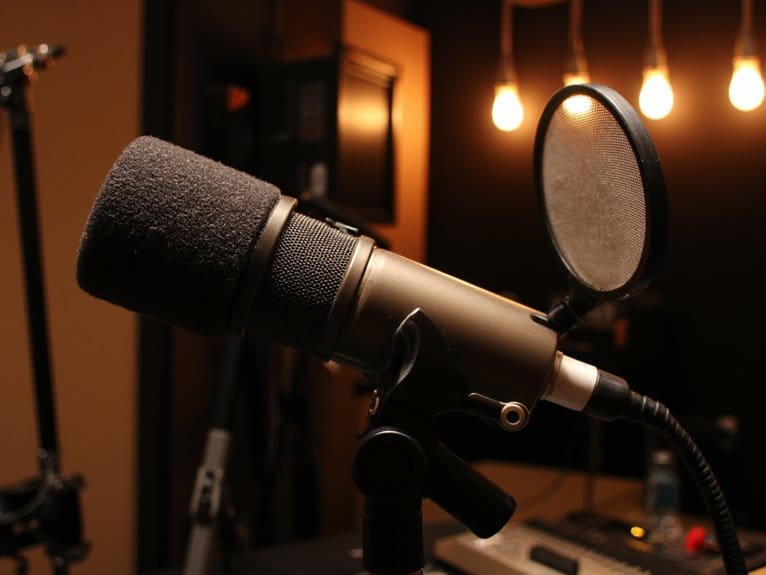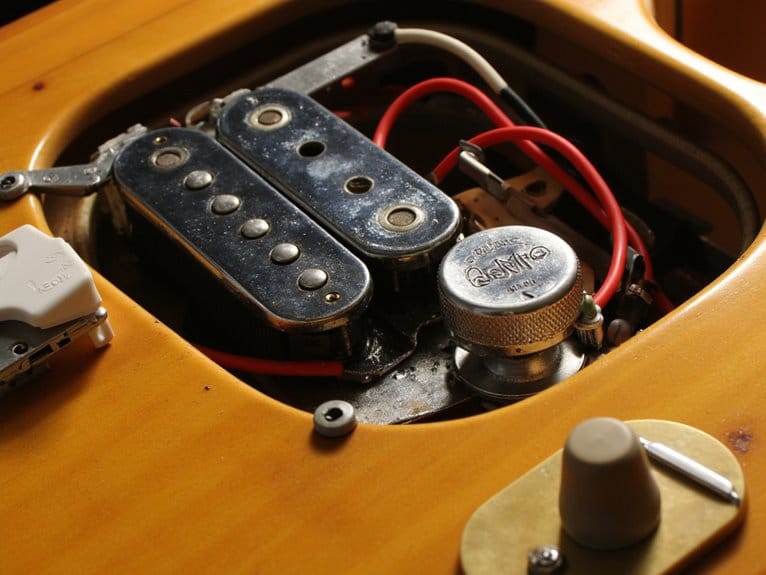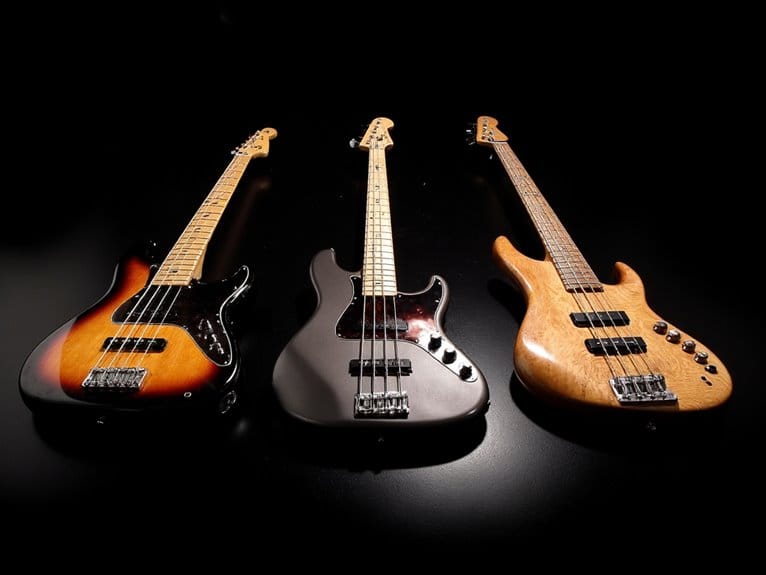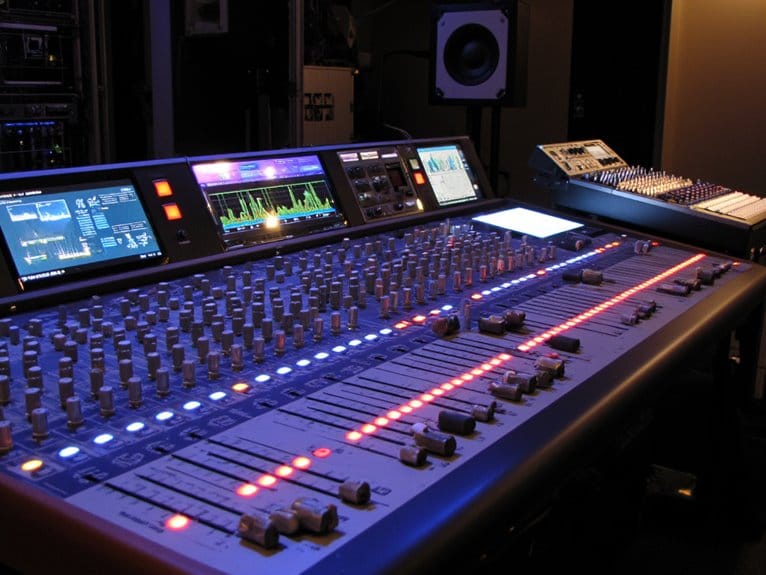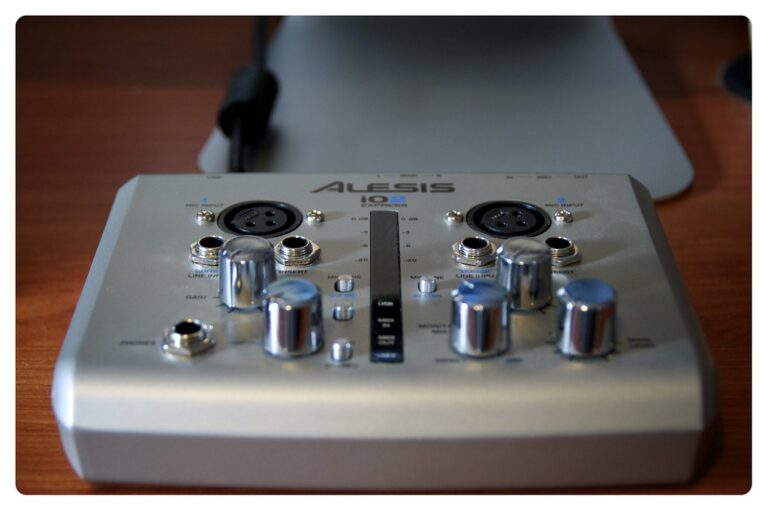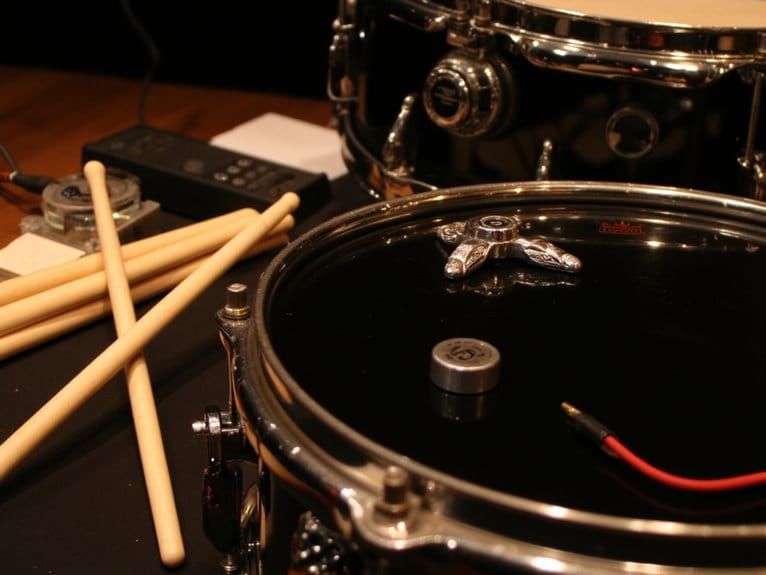Understanding Microphone Windscreens and Pop Filters
You’ll need windscreens for outdoor recording since they block wind noise and environmental sounds using foam or synthetic fur that covers your microphone completely, while pop filters excel at diffusing plosive consonants during close vocal work with their nylon or metal mesh stretched across circular frames. Windscreens slightly dampen higher frequencies but protect against moisture and debris, whereas pop filters maintain acoustic transparency while eliminating harsh air blasts from speech. Understanding their combined usage opens up professional recording techniques.
We are supported by our audience. When you purchase through links on our site, we may earn an affiliate commission, at no extra cost for you. Learn more.
Notable Insights
- Windscreens protect microphones from wind noise and environmental elements, while pop filters diffuse plosive consonants during close vocal work.
- Windscreens use foam or synthetic fur for complete microphone coverage, pop filters use nylon or metal mesh in adjustable frames.
- Pop filters are essential for studio vocals and podcasts, windscreens are vital for outdoor recording and live broadcasting.
- Both accessories can be used together for optimal results in challenging recording conditions without compromising audio quality.
- Windscreens may slightly dampen high frequencies, while pop filters maintain acoustic transparency and frequency response during recording sessions.
Primary Functions and Core Differences
While both windscreens and pop filters solve audio problems that’ll make your recordings sound amateurish, I’ve found they’re actually designed for completely different challenges in the recording world.
Windshield benefits include protecting your microphone from wind noise, ambient outdoor sounds, and environmental elements like moisture and dust, making them essential for field recording and live broadcasting situations.
Windscreens are indispensable for outdoor recording, shielding microphones from wind interference and environmental hazards that compromise audio quality.
Pop filter differences become apparent in studio environments, where they’re specifically engineered to diffuse plosive consonants and harsh air blasts from close vocal work.
I’ve noticed windscreens attach directly to your microphone and slightly dampen higher frequencies, while pop filters maintain sonic transparency through their mesh construction and external positioning between you and the microphone. Wind noise often creates problematic interference in the sub-500Hz range, which can clash with human vocal frequencies. Both tools can be used together to achieve optimal results when facing particularly challenging recording conditions. When selecting a good microphone for streaming, it’s essential to consider how these accessories can enhance audio quality. A high-quality microphone paired with an effective windscreen or pop filter can significantly reduce unwanted noise, allowing your voice to shine through clearly. This attention to audio detail can enhance the overall experience for your listeners, making your content more engaging.
Material Construction and Physical Design
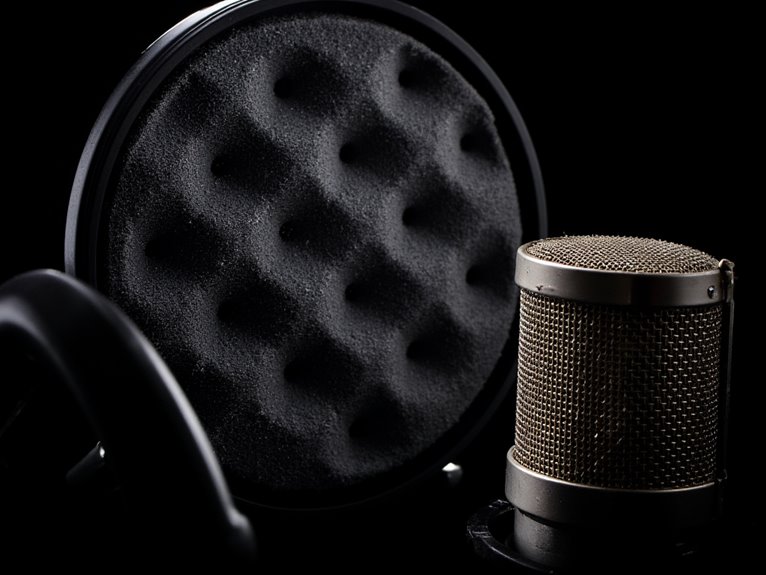
When you examine the materials and construction methods behind these audio accessories, you’ll discover that the physical differences between windscreens and pop filters directly impact their acoustic performance and practical applications.
Windscreens utilize foam or synthetic fur that wraps completely around your microphone’s capsule, creating a snug barrier that absorbs fast-moving air while slightly dampening higher frequencies.
Pop filters, conversely, employ stretched nylon or fine metal mesh within circular frames positioned several inches from your mic, allowing acoustic transparency while dispersing plosive bursts.
The materials impact extends beyond basic functionality—foam density affects wind reduction capability, while metal meshes offer superior durability with minimal frequency attenuation. Nylon pop filters absorb higher frequencies while remaining the most commonly used type in recording environments.
This design versatility means you’ll find windscreens molded for specific microphone types, whereas pop filters provide adjustable positioning through flexible mounting arms. Pop filters typically attach to microphone stands rather than connecting directly to the microphone housing itself.
Studio Recording Applications
In professional studio environments, where pristine audio quality determines the difference between amateur and broadcast-ready recordings, pop filters have become an indispensable tool for vocal capture, while windscreens serve more specialized secondary roles. When you’re implementing proper studio techniques, pop filters excel at eliminating plosives without compromising frequency response, making them essential for podcast setups, voiceover work, and solo vocal sessions where sound isolation demands perfection. Many recording engineers find that both tools can enhance sound quality when used correctly in different recording situations. Pop filters also provide moisture protection for sensitive microphones by preventing breath droplets from reaching the diaphragm during extended recording sessions. Understanding your microphone’s frequency response range, such as 20Hz-20KHz, helps determine which acoustic filtering solution will maintain optimal audio clarity. Professional studios typically budget $30-60 for quality accessories including boom arms and pop filters to enhance overall microphone performance.
| Pop Filters | Windscreens |
|---|---|
| Primary plosive control | Secondary breath noise reduction |
| Positioned off-microphone | Direct microphone coverage |
| Maintains vocal brightness | Slight high-frequency dampening |
| Professional vocal recording | Condenser microphone protection |
While windscreens occasionally supplement condenser microphones against breath sounds, they can muffle high frequencies, requiring careful consideration in your recording chain to avoid extensive post-processing corrections.
Outdoor and Field Recording Scenarios
When you’re recording outdoors, I’ve found that wind becomes your biggest enemy, transforming crystal-clear audio into a rumbling mess of low-frequency interference that can completely destroy your recording.
Your microphone’s naked capsule catches every gust, subtle breeze, and sudden air movement, creating unwanted noise that’s nearly impossible to remove in post-production without sacrificing the natural quality of your intended audio. The unpredictable weather conditions make windscreens essential equipment for any serious outdoor recording session.
That’s where proper wind noise protection and environmental shielding become absolutely critical, because even the most expensive microphone won’t deliver professional results if you can’t control the harsh realities of outdoor recording environments. Professional pop filters serve as valuable tools for outdoor recordings, effectively managing wind noise while preserving the integrity of your audio capture.
Wind Noise Protection
Why does that perfect outdoor recording suddenly sound like you’re broadcasting from inside a washing machine?
Wind noise creates low-frequency rumble and broadband interference that’ll overpower your desired audio signals, turning professional recordings into unusable garbage.
I’ve learned that effective wind reduction requires matching your protection to conditions—foam windscreens handle light breezes adequately, while furry windjammers reduce outdoor noise by 20-30 dB in stronger gusts.
For extreme conditions, blimps with cage enclosures offer maximum protection by dispersing wind before it reaches your microphone capsule.
You’ll want multiple windscreens ready since wet coverings degrade sound quality markedly. High humidity above 90% can impair microphone function and make foam materials less effective.
Combine physical protection with low-cut filters to tackle wind-induced input overload, and always position microphones behind natural barriers when possible. Ensuring proper compatibility between your windscreen and microphone model prevents loose fitting that can reduce protection effectiveness.
Environmental Shield Benefits
Beyond shielding your microphone from wind interference, environmental protection becomes your first line of defense against the relentless assault of outdoor elements that’ll destroy both your recordings and expensive gear.
Dust particles, moisture, and debris constantly threaten sensitive microphone components, particularly during field recordings where you can’t control atmospheric conditions. Quality windscreens act as physical barriers, extending your microphone’s lifespan while maintaining professional audio standards in unpredictable environments.
Windshield effectiveness directly impacts outdoor acoustics by filtering environmental interference beyond simple wind noise, including rustling vegetation and vehicular disturbances.
Whether you’re capturing wildlife sounds or conducting interviews, properly fitted windscreens preserve audio integrity without sacrificing the natural ambiance that makes outdoor recordings compelling, ensuring your investment in expensive microphones pays dividends across countless recording sessions.
Plosive Sound Control and Vocal Clarity
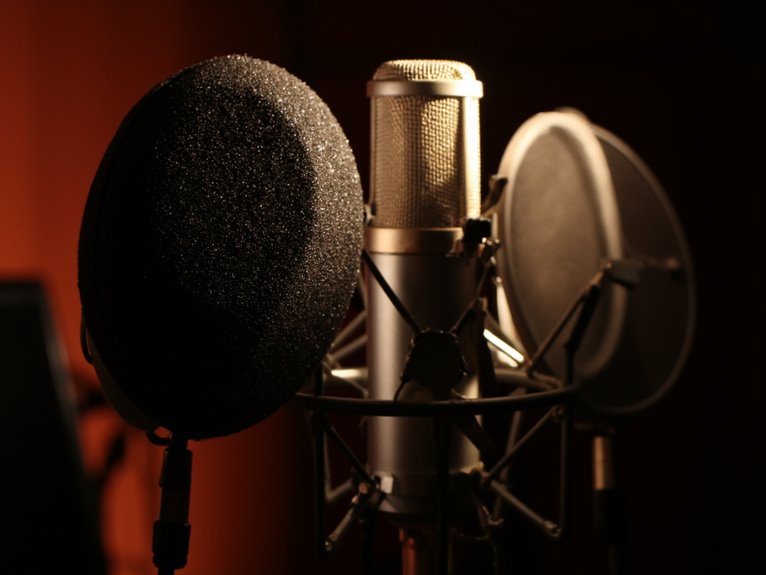
When you’re recording vocals, you’ll encounter plosive sounds—those sharp bursts of air from consonants like “p,” “b,” “t,” and “k”—that create annoying pops and distortion in your audio, and honestly, they’re one of the most frustrating issues I’ve dealt with in years of recording.
Pop filters excel at controlling these plosives by using thin mesh or nylon material that disperses airflow before it hits your microphone’s diaphragm. In addition to managing plosives, pop filters can also enhance the overall clarity of recordings by allowing for a more consistent sound. They work well alongside other techniques, including eliminating microphone handling noise techniques, to ensure that audio quality remains high. By integrating these elements into your recording setup, you can achieve a more professional sound with minimal distractions.
Windscreens, though helpful for wind noise, aren’t specifically designed to tackle these vocal challenges effectively.
Understanding how pop filters enhance vocal clarity by preserving your natural tone while eliminating those distracting air blasts will help you achieve professional-quality recordings that require minimal post-production work.
What Are Plosives
Although I’ve spent countless hours working with microphones in various recording environments, it wasn’t until I started analyzing frequency responses in detail that I truly understood how plosives wreak havoc on vocal clarity.
Plosives are consonant sounds like “p,” “b,” “t,” “d,” “k,” and “g” that you create by temporarily blocking airflow in your vocal tract, then releasing it suddenly. This creates a burst of air that hits your microphone’s diaphragm, causing those annoying pops and booms.
Here’s what happens when plosive effects strike your recordings:
- Your microphone captures sudden air pressure spikes that create low-frequency booms
- Audio distortion occurs when these bursts overpower your microphone’s diaphragm capacity
- Other vocal frequencies get masked, reducing overall intelligibility and professional quality
Frequently Asked Questions
Can I Use Both a Pop Filter and Windscreen Simultaneously?
Yes, you can absolutely use both simultaneously, and I’d argue it’s often the smartest approach for versatile recording setups.
Using pop filters handles those explosive plosive sounds during vocal work, while the benefits of windscreens become apparent when you’re dealing with environmental noise, airflow, or outdoor conditions.
This dual-layer protection reduces your post-production workload considerably, giving you cleaner audio straight from the source.
Do Pop Filters and Windscreens Affect Microphone Frequency Response?
Both accessories do affect your microphone’s frequency response, though pop filters maintain better sound quality overall.
I’ve found that windscreens create more noticeable high-frequency attenuation due to their foam construction, which can dampen brightness and airiness in recordings.
Pop filters, with their mesh design, preserve your mic’s natural frequency response much better while still eliminating plosives effectively.
Can I Make a DIY Pop Filter at Home?
You can absolutely create an effective pop filter using common DIY materials like wire coat hangers, nylon stockings, and rubber bands.
I’ve found that homemade versions, when constructed properly with tightly stretched fabric, perform surprisingly well compared to commercial options.
The effectiveness comparison shows DIY filters block plosives adequately for most recording situations, though they may lack the durability of professional models.
On a final note
You’ve now got the knowledge to choose between windscreens and pop filters confidently, understanding that foam windscreens excel at outdoor wind protection while fabric pop filters dominate studio plosive control. I’ve found that proper positioning matters more than expensive gear, and honestly, you’ll probably need both eventually. Remember, there’s no perfect solution for every situation, but you can’t go wrong starting with a basic pop filter for indoor recording.

